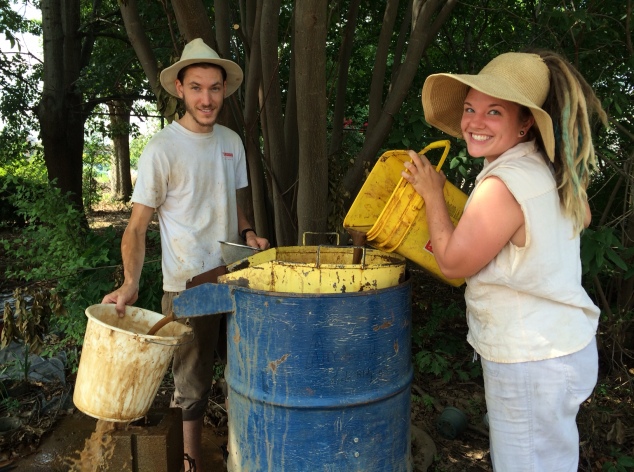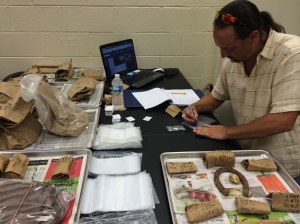As was mentioned in the previous post, we have many samples that are undergoing a process called “flotation.” We have well over 400 bags that range from 20-100+ lbs of feature samples to process this way. The students are working in 4-5 hour shifts five days a week to complete all of these by Friday, August 8th (and will be rewarded with a BBQ picnic lunch prepared by me, Dr. Peres! [and a good grade, too]). We have been fortunate to have an awesome faculty and staff at the MTSU Greenhouses that have given us lots of space, logistical support, and interest to get this job done. It is helpful for them, too — they get all of the organic residual sediments for composting. So thanks to Dr. Nate Phillips, Larry Sizemore, the Greenhouse staff, and of course the graduate students, who have taken an interest and given us a flotation home!
The rest of the blog post is by Clacey Farley and Lee Van Sickle. I challenged them to not only write a post about flotation, but to be creative and “make a video or something.” They did a great job on their first video to show you, our blog readers, what they do every day.
***************************************************
by Clacey Farley and Lee Van Sickle
What is flotation?
Flotation = Reduction, very systematically.
We take large bags of sediment rocks and other items, wash, and reduce them to smaller bags for further analysis. We pre-soak the large bags in water-filled buckets before transferring them onto a large set of screens inside of a 50 gallon flotation tank that resembles a giant pitcher.

Lee and Clacey working at the flotation tank.
Inside the tank is a small sprinkler to generate water for washing off the dirt. The heavy items (fire cracked rocks, flint, etc.) or heavy fraction sink to the bottom of the screens and are removed and placed on trays to dry. What happens to the stuff that floats to the top? Well, the lighter items (plant remains, carbonized pieces, etc.) or light fraction cascades out of the top of the tank and into a bucket with another sieve to catch it. It is then placed on a separate tray for drying, just like the heavy fraction and then they are both dried and bagged again alongside tags indicating which feature the material is from. Then they are taken to the lab where another team processes them further.
As of Thursday, July 31, over 336 bags had been floated. This includes down-time for patching and repairing torn screens, building mud walls to divert the runoff to a specific location, lectures in the archaeology lab, and the unloading of more bags as they are brought in from field storage. We’ve learned the value of multitasking and the importance of double- (and triple-) checking! It is also nice to know that we can trust our teammates to do the same. When we have to look away, we have the security of knowing the project is still in safe hands!


